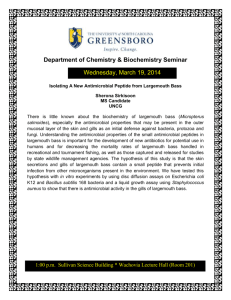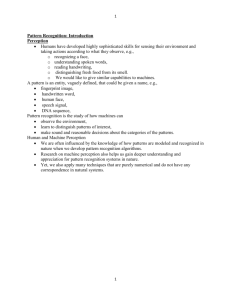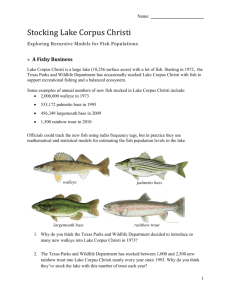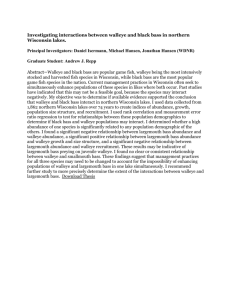Micropterus salmoides
advertisement
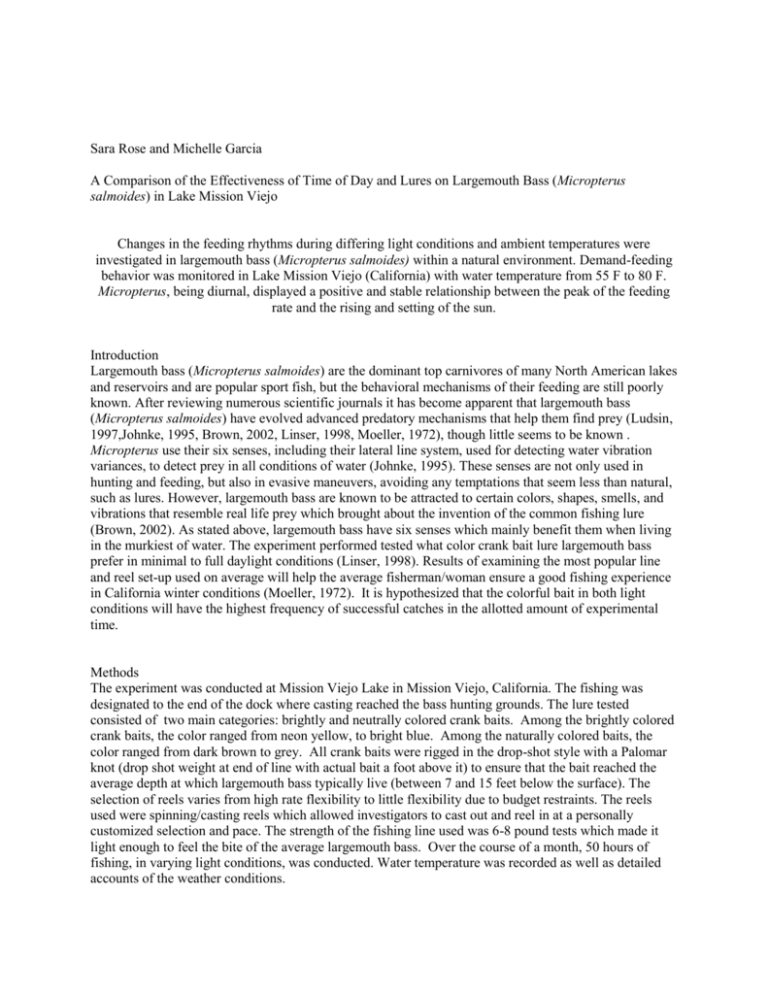
Sara Rose and Michelle Garcia A Comparison of the Effectiveness of Time of Day and Lures on Largemouth Bass (Micropterus salmoides) in Lake Mission Viejo Changes in the feeding rhythms during differing light conditions and ambient temperatures were investigated in largemouth bass (Micropterus salmoides) within a natural environment. Demand-feeding behavior was monitored in Lake Mission Viejo (California) with water temperature from 55 F to 80 F. Micropterus, being diurnal, displayed a positive and stable relationship between the peak of the feeding rate and the rising and setting of the sun. Introduction Largemouth bass (Micropterus salmoides) are the dominant top carnivores of many North American lakes and reservoirs and are popular sport fish, but the behavioral mechanisms of their feeding are still poorly known. After reviewing numerous scientific journals it has become apparent that largemouth bass (Micropterus salmoides) have evolved advanced predatory mechanisms that help them find prey (Ludsin, 1997,Johnke, 1995, Brown, 2002, Linser, 1998, Moeller, 1972), though little seems to be known . Micropterus use their six senses, including their lateral line system, used for detecting water vibration variances, to detect prey in all conditions of water (Johnke, 1995). These senses are not only used in hunting and feeding, but also in evasive maneuvers, avoiding any temptations that seem less than natural, such as lures. However, largemouth bass are known to be attracted to certain colors, shapes, smells, and vibrations that resemble real life prey which brought about the invention of the common fishing lure (Brown, 2002). As stated above, largemouth bass have six senses which mainly benefit them when living in the murkiest of water. The experiment performed tested what color crank bait lure largemouth bass prefer in minimal to full daylight conditions (Linser, 1998). Results of examining the most popular line and reel set-up used on average will help the average fisherman/woman ensure a good fishing experience in California winter conditions (Moeller, 1972). It is hypothesized that the colorful bait in both light conditions will have the highest frequency of successful catches in the allotted amount of experimental time. Methods The experiment was conducted at Mission Viejo Lake in Mission Viejo, California. The fishing was designated to the end of the dock where casting reached the bass hunting grounds. The lure tested consisted of two main categories: brightly and neutrally colored crank baits. Among the brightly colored crank baits, the color ranged from neon yellow, to bright blue. Among the naturally colored baits, the color ranged from dark brown to grey. All crank baits were rigged in the drop-shot style with a Palomar knot (drop shot weight at end of line with actual bait a foot above it) to ensure that the bait reached the average depth at which largemouth bass typically live (between 7 and 15 feet below the surface). The selection of reels varies from high rate flexibility to little flexibility due to budget restraints. The reels used were spinning/casting reels which allowed investigators to cast out and reel in at a personally customized selection and pace. The strength of the fishing line used was 6-8 pound tests which made it light enough to feel the bite of the average largemouth bass. Over the course of a month, 50 hours of fishing, in varying light conditions, was conducted. Water temperature was recorded as well as detailed accounts of the weather conditions. Results The overall number of fish caught using the bright and naturally-colored lures were graphed using a bar graph on Micrisoft Excel (Figure 1). Figure 1 7 # of Fish Caught 6 5 4 3 2 1 0 Brightly-colored Lures Naturally-colored Lures Shaking Deep-diving Lures The amount of fish caught during low light or bright light conditions is graphed in Figure 2. Figure 2 8 # of Fish Caught 7 6 5 4 3 2 1 0 Low Light Conditions Bright Light Conditions Light Conditions Lastly, the two graphs constructed below (Figures 3&4) display the amount of fish caught with naturallycolored and brightly-colored lures in both low light conditions (sunrise and sundown beyond) and bright light conditions (between sunrise and sunset). Figure 3 7 # of Fish Caught 6 5 4 3 2 1 0 Brightly-colored Lure Naturally-colored Lure Low Light Conditions Fig. 3 caption- The above graphs shows the amount of fish caught in low light conditions. (p=0.33+/- S.E.M. 1.5) Figure 4 6 # of Fish Caught 5 4 3 2 1 0 Brightly-colored Lure Naturally-colored Lure Bright Light Conditions Fig.4 caption- The above graph shows the amount of fish caught in bright light conditions. (S.E.M. +/- 0.5) The data was collected to compare the number of fish caught in bright and low lights conditions to perform an unpaired two-tailed test assuming equal variances. The data showed a significant difference in the number of fish caught in low light conditions versus bright light conditions (p=0.33). The data showed that fishing in low light conditions produced more fish caught then fishing in bright light conditions. The data was run through a descriptive statistics test to determine the standard error means. Discussion When considering the rate of success with any given kind of bait, one must look at how Micropterus experiences the bait through all six of its senses. According to a study on pisciverous feeding in Micropterus “In the pursuit phase of the predation cycle, largemouth bass are more likely to choose prey with large apparent size, closer proximity, or greater motion.” (Howick, 1983). A complete analysis of their finding showed that bass use multiple mechanisms simultaneously to determine which organisms to prey on. First, we examine sight. The brightly colored lures are easier to see in murky water, however, it is still unknown the range of colors which Micropterus can actually see. According to a recent study, bass may have some, but not full, color vision (Kawamura, 2002). This most likely is cause of the bass’ lack of interest in the unnatural, brightly colored lures. A keen sense of smell is perhaps another contributing factor to why Micropterus rarely approaches lures. In such murky (visibility of the lake was measured to be between 8ft-15ft in bright condition and 3-9ft in low light conditions) water, it is highly likely that bass depend on their eyesight and more so on their other senses. If a lure gives off a plastic scent, or perhaps even no scent at all, it is likely that the bass are not even considering it an option as a food item as they hunt through the algae. A sense of taste is imperative to many organisms in determining what food items will be most nutritious. Largemouth bass use a glossopharyngeal taste system (Ogawa, 1999) to sample and understand potential food items before consuming them. The bass will swallow potential prey and spit it out or swallow it depending on taste. A big part of the reason that bass take in so much information about their prey before attempting to consume them is because of the mechanism by which they feed. The final sense that Micropterus uses is the lateral line system that all fish use to detect vibrations and pressure differences in the water (Bleckmann, 2009). Micropterus use this sense to hunt prey in the wild by having the ability to even detect the heartbeat of nearby prey. Using these senses in unison is what has made Mircropterus a popular sport-fishing trophy, because it does not take merely a fishing pole and hook to capture this predator. As the results show, the most favorably condition to fish for largemouth bass is in low light. This indicates that lower temperatures are also favorable since temperature corresponds with changes in different light conditions (i.e. hot in the day and cool at night). It became apparent after recording data that Mircropterus gave more attention to the lures painted to imitate the colors of fish in the wild (naturally-colored lures). The results did not show a significant difference, but if more research with spot fishing was conducted then it could possible show that Mircropterus will spend more time analyzing the naturally-colored lures. The results are from a small sample set and in the future data might be taken from professional fishermen in order to have more accurate and precise results. References Bleckmann Horst, Zelick Randy, (2009). Lateral line system of fish. Integrative Zoology 4, 13-25 Carrol, A. M., (2004). Muscle activation and strain during suction feeding in the largemouth bass Micropterus salmoides. Journal of Experimental Biology 207, 983-991 Grant, B. E., Devon, Gershaneck L., Plata D. L., and Golub J. L. (2002). Ontogenetic Changes in Response to Heterospecific Alarm Cues by Juvenile Largemouth Bass are Phenotypically Plastic. Behavior, 139(7), 913-927. Howick, G. L., O’Brien, J. W., (1983). Piscivorous Feeding Behavior of Largemouth Bass: An Experimental Analysis. Transactions of the American Fisheries Society. 112, 508-516. Johnke, W. K., (1995). The Behavior and Habits of Largemouth Bass. Dorbil Publishing Co.. New York. Kawamura, G., Kashimoto, T., (2002). Color vision, accommodation and visual acuity in the largemouth bass. Fisheries Science. 68(5), 1041-1046. Linser, P. J., Carr, William E. S., Cate, H. S., Derby, C. D., & Netheron, J. C. (1957). Functional Significance of the Co-Localization of Taste Buds and Teeth in the Pharyngeal Jaws of the Largemouth Bass, Micropterus salmoides. Biological Bulletin, 195(3), 273-281. Ludsin, S. A., & DeVries, D. R..(1997). First-Year Recruitment of Largemouth Bass: The Interdependency of Early Life Stages. Ecological Applications, 7(3), 1024-1038. Moeller, G. H., & Engelken, J. H..(1972). What Fishermen Look for in a Fishing Experience. The Journal of Wildlife Management, 36(4), 1253-1257. Ogawa, K., Caprio, J., (1999). Citrate Ions Enhance Taste Response to Amino Acids in Largemouth Bass. The Journal of Neurophysiology, 81(4). Pawson, M.G., Pickett, G.D., Leballeur, J., Brown, M., & Fritsch, M.. (2007). Migrations, fishery interactions, and management units of sea bass (Dicentrarchus labrax) in Northwest Europe. ICES Journal of Marine Science: Journal du Conseil Rutherford, E. S., Rose, K. A., Cowan Jr., K. H.. (2003) Evaluation of the Shepherd and Cushing (1980) model of density-dependent survival: a case study using striped bass (Morone saxatilis) larvae in the Potomac River, Maryland, USA. ICES Journal of Marine Science: Journal du Conseil.
